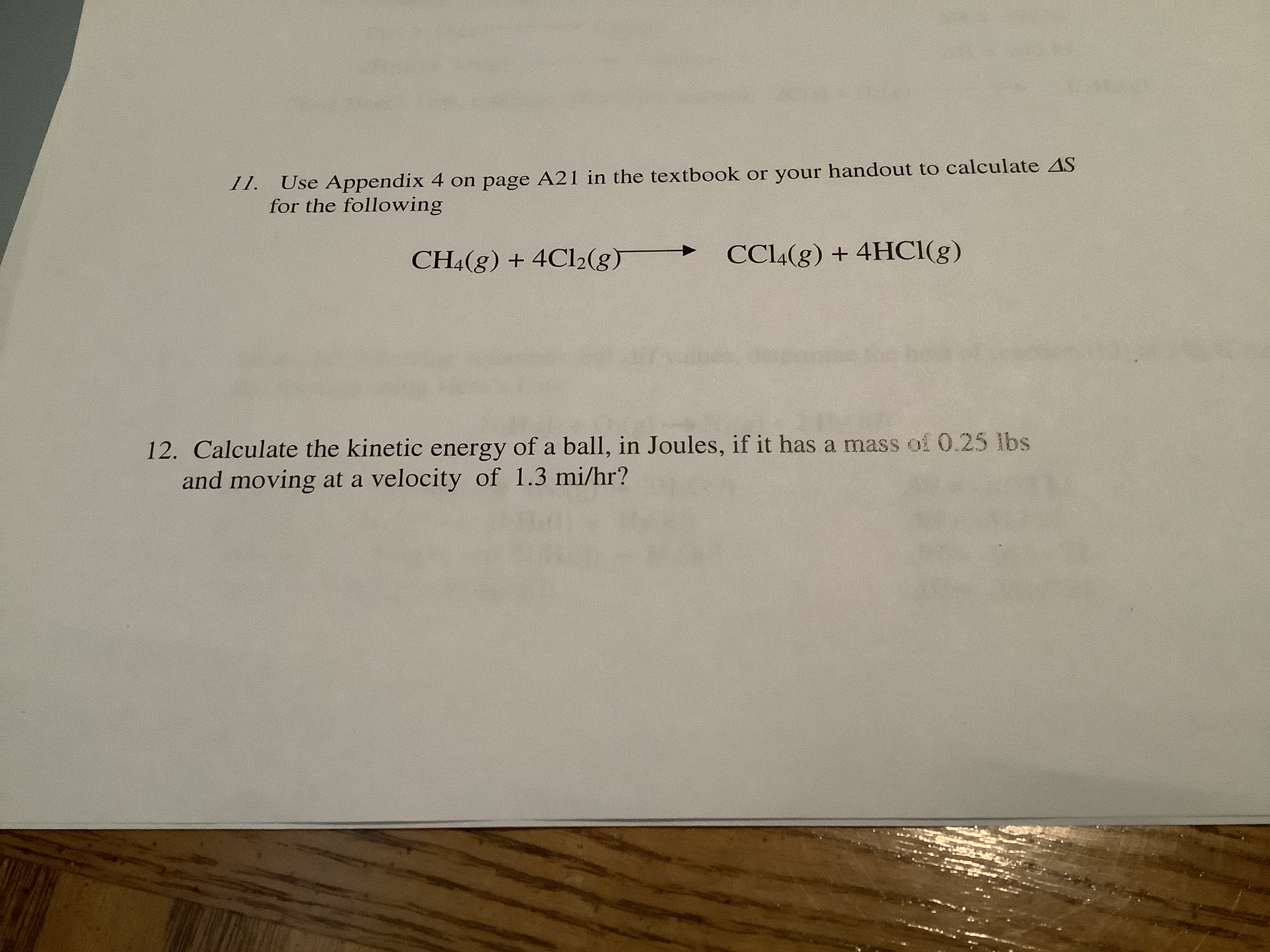
Chemistry
10th Edition
ISBN: 9781305957404
Author: Steven S. Zumdahl, Susan A. Zumdahl, Donald J. DeCoste
Publisher: Cengage Learning
expand_more
expand_more
format_list_bulleted
Concept explainers
Question
Can you please help me understand how to get the answer to this question?
12. Calculate the kinetic energy of a ball, in Joules, if it has a mass of 0.25 lbs and moving at a velocity of 1.3 mi/hr?

Transcribed Image Text:11.
Use Appendix 4 on page A21 in the textbook or your handout to calculate AS
for the following
CC14(g) + 4HC1(g)
CH4(g) + 4C12(g)
12. Calculate the kinetic energy of a ball, in Joules, if it has a mass of 0.25 lbs
and moving at a velocity of 1.3 mi/hr?
Expert Solution
This question has been solved!
Explore an expertly crafted, step-by-step solution for a thorough understanding of key concepts.
This is a popular solution
Trending nowThis is a popular solution!
Step by stepSolved in 2 steps with 1 images

Knowledge Booster
Learn more about
Need a deep-dive on the concept behind this application? Look no further. Learn more about this topic, chemistry and related others by exploring similar questions and additional content below.Similar questions
- Calculate the change in energy for the following processes and identify if the process is endothermic or exothermic. 1. How much heat is released by a system when 45 J of work is done on it to decrease its energy to 23 J? 2. What is the work done by a system when it absorbs 47 J of heat and gain 12 J of energy? 3. A gas absorbs 51 J of heat as it does 96 J of work. with explanation and solution please.arrow_forwardWhen two solutions are combined in a test tube, they quickly react and the test tube containing the reaction becomes instantly hot to the touch. Is this reaction exothermic or endothermic? Briefly explain how you know.arrow_forwardAn unknown solid metal at 150 degrees celsius was placed in 1.00 L of water at 25 degrees celsius. The final temperature of the solid metal in the water was 26.3 degrees celsius. In order to find the specific heat of the metal, what additional information is needed?arrow_forward
- In an experiment, 26.5 g of metal was heated to 98.0°C and then quickly transferred to 150.0 g of water in a calorimeter. The initial temperature of the water was 22.5°C, and the final temperature after the addition of the metal was 32.5°C. Assume the calorimeter behaves ideally and does not absorb or release heat.arrow_forward3arrow_forwardPlease help me complete this questionarrow_forward
- What are some examples of exothermic and endothermic reactions or processes you've seen in real life aside from hot and cold packs?arrow_forward2 moles of lithium metal reacts with liquid water to produce solid lithium hydroxide, hydrogen gas, and 402.4 kJ/mol of heat energy. a) write a balanced thermochemical equation for the reaction b) how much heat would be produced by the reaction of 14 g of lithium with an excess of liquid water c) is the reaction endothermic or exothermic?arrow_forwardAlexia determined the mass of her empty Styrofoam cup calorimeter was 1.0698 g. She then added distilled water to the cup and weighed it again. The combined mass of the cup + water was 33.2191 g. What is the mass of water, in g, in Alexia's cup?arrow_forward
- When substances are dissolved in water, they can absorb or release heat. Describe how you would use a calorimeter to determine the amount of heat required or released to when 10 grams of sugar is dissolved in 100 grams of water. Describe how you would calculate the heat absorbed or released by the sugar with the data you collect. (Do no perform any calculations.)arrow_forward1. A thermometer placed in a solution undergoing a chemical reaction indicates an increase in temperature as the reaction proceeds. Is this reaction endothermic or exothermic? Describe if heat energy is lost or gained from the reaction (the system) to the surroundings. What is the sign of the enthalpy change (AH) of this reaction? 2. A student performs a reaction and determines the enthalpy change (AH) to be 31.4 kJ. Will the temperature of the surrounding solution increase or decrease as a result of this chemical process? 3. If you hold 3 grams of ice in your hand at room temperature, your hand will become cold. a) Is the reaction H,O(s) – H,O(1) endothermic or exothermic? b) In which direction does heat flow?arrow_forwardHow much heat is released when 22.75 g oxygen gas is used in the reaction? (Pay close attention to the units your given is in! Maybe need a conversion first?) 4 Fe+ 3 O2 → 2 Fe2O3 ΔH = -1652 kJarrow_forward
arrow_back_ios
arrow_forward_ios
Recommended textbooks for you
 ChemistryChemistryISBN:9781305957404Author:Steven S. Zumdahl, Susan A. Zumdahl, Donald J. DeCostePublisher:Cengage Learning
ChemistryChemistryISBN:9781305957404Author:Steven S. Zumdahl, Susan A. Zumdahl, Donald J. DeCostePublisher:Cengage Learning ChemistryChemistryISBN:9781259911156Author:Raymond Chang Dr., Jason Overby ProfessorPublisher:McGraw-Hill Education
ChemistryChemistryISBN:9781259911156Author:Raymond Chang Dr., Jason Overby ProfessorPublisher:McGraw-Hill Education Principles of Instrumental AnalysisChemistryISBN:9781305577213Author:Douglas A. Skoog, F. James Holler, Stanley R. CrouchPublisher:Cengage Learning
Principles of Instrumental AnalysisChemistryISBN:9781305577213Author:Douglas A. Skoog, F. James Holler, Stanley R. CrouchPublisher:Cengage Learning Organic ChemistryChemistryISBN:9780078021558Author:Janice Gorzynski Smith Dr.Publisher:McGraw-Hill Education
Organic ChemistryChemistryISBN:9780078021558Author:Janice Gorzynski Smith Dr.Publisher:McGraw-Hill Education Chemistry: Principles and ReactionsChemistryISBN:9781305079373Author:William L. Masterton, Cecile N. HurleyPublisher:Cengage Learning
Chemistry: Principles and ReactionsChemistryISBN:9781305079373Author:William L. Masterton, Cecile N. HurleyPublisher:Cengage Learning Elementary Principles of Chemical Processes, Bind...ChemistryISBN:9781118431221Author:Richard M. Felder, Ronald W. Rousseau, Lisa G. BullardPublisher:WILEY
Elementary Principles of Chemical Processes, Bind...ChemistryISBN:9781118431221Author:Richard M. Felder, Ronald W. Rousseau, Lisa G. BullardPublisher:WILEY

Chemistry
Chemistry
ISBN:9781305957404
Author:Steven S. Zumdahl, Susan A. Zumdahl, Donald J. DeCoste
Publisher:Cengage Learning

Chemistry
Chemistry
ISBN:9781259911156
Author:Raymond Chang Dr., Jason Overby Professor
Publisher:McGraw-Hill Education

Principles of Instrumental Analysis
Chemistry
ISBN:9781305577213
Author:Douglas A. Skoog, F. James Holler, Stanley R. Crouch
Publisher:Cengage Learning

Organic Chemistry
Chemistry
ISBN:9780078021558
Author:Janice Gorzynski Smith Dr.
Publisher:McGraw-Hill Education

Chemistry: Principles and Reactions
Chemistry
ISBN:9781305079373
Author:William L. Masterton, Cecile N. Hurley
Publisher:Cengage Learning

Elementary Principles of Chemical Processes, Bind...
Chemistry
ISBN:9781118431221
Author:Richard M. Felder, Ronald W. Rousseau, Lisa G. Bullard
Publisher:WILEY